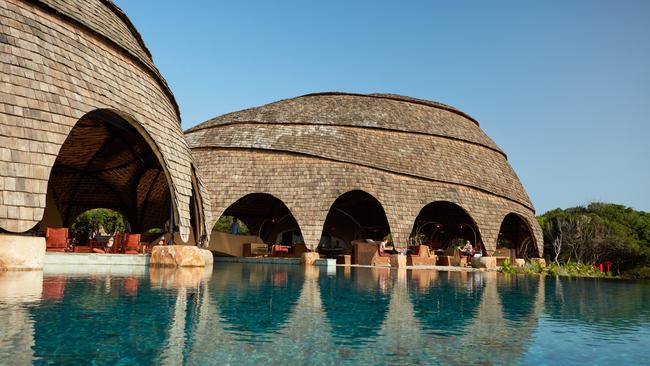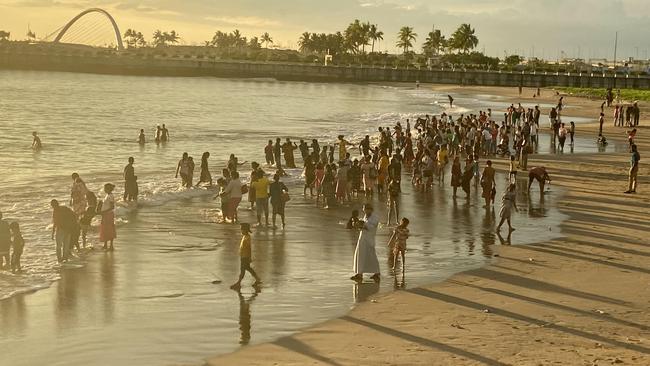This island the size of Tasmania should be on your 2025 bucket list
Rocked by years of crises, the beautiful island nation – with a population of about 22 million – is undergoing a revival. For travellers, exploration offers deep rewards.

The sun is edging over the Indian Ocean, lighting up a pristine beach marked only by the divots of elephant feet and patter of wild boar. A sturdy monitor lizard catches rays high on the dunes and dozens of frogs, spooked by our shadows, dance across a pond like skipping stones. Plop, plop, plop; it’s a comical sight. Our guide sighs deeply as we survey this sea-meets-jungle landscape on Sri Lanka’s wild southeast coast and sums up the conversation that has dominated our sunrise stroll: “We have hope now,’’ he says.
He’s not referring to the elephants and leopards we hope to spot later that afternoon in nearby Yala National Park. It’s the day after Sri Lanka’s parliamentary elections and there are bigger things at play: the new president’s National People’s Power coalition party has won a landslide victory and mandate for sweeping change.
From tuk-tuk drivers to shop owners, food-cart workers to office managers, there’s a buzz of expectation. “Hope” is a word repeated in almost every conversation on a topic everyone wants to talk about. There is no escaping the significance of this moment. “In Sri Lanka, we always seem to take one step forward and three steps back,’’ says a fishing boss as we watch lines of elderly men work for hours hauling fishing nets ashore. “Now, we might keep moving forward.’’

There’s chatter in the hotels and bars, too. Boosting the vital tourism sector is on the agenda of new President Anura Kumara Dissanayake, who wants his country to surpass the glory days of 2018 and early 2019 when it featured on every “must visit” list and was crowned the world’s No. 1 travel destination by Lonely Planet.
The 2019 Easter Islamist-linked terror attacks on churches and hotels that killed more than 250 people, followed by the Covid pandemic and the economic collapse of 2022 that sent the country into bankruptcy and felled the ruling Rajapaksa family dynasty, put paid to that.
Now, with the promise of political stability and seeds of economic growth, we feel the optimism on a two-week November trip that takes in the laid-back capital, Colombo, down to the surf beaches of the southern coast, through the country’s wildlife-filled Yala National Park to the tea plantations of the central highlands and sacred city of Kandy.
This island nation – slightly smaller than Tasmania, with a population of about 22 million – offers a rich tourist experience. It still has its challenges but as we move about by train, taxi and tuk-tuk, talking to locals from all gamuts of life, it’s hard not to get caught up in the promise of a new dawn.

■ ■ ■
A warm breeze ruffles the flames of a camp fire as we settle into our headland perch just outside Yala National Park. With local arrack (a coconut spirit) and passionfruit cocktails in hand, we watch the blazing sunset as a full moon sneaks over our shoulders. In the surreal orange glow, grey langur monkeys quietly feed in the shadows and rangers patrol the perimeter on elephant alert. We are in the unfenced national park buffer zone at Wild Coast Tented Lodge and it’s not unknown for wild creatures to wander into camp.

It’s sundowners time at the safari-style camp, which is known for its two striking boulder-shaped teak-and-bamboo domes that house a restaurant, bar, library and part of the large infinity pool. A series of paths through the bush connects these main pavilions to 28 raised canvas suites – some with their own pool, which shouldn’t be used at night. “You never know what you might be swimming with,” we’re warned.
The generous rooms are called “cocoons” and that doesn’t only describe their appearance. Our air-conditioned refuge is all rustic charm with its four-poster bed and thick rugs, timber-and-leather furnishings and a deep copper bathtub, just the thing after bumping around nearby Yala in the back of an open-air safari vehicle on the lookout for leopards and elephants.


Overtourism in the national park is sparking debate over how to manage the lines of safari trucks that crawl the roads, creating mini traffic jams around leopard or elephant sightings and killing the vibe of natural immersion. We appreciate Wild Coast’s guides, who are not only knowledgeable but aware that guests don’t want to join queues of tourists ogling a single elephant. We take quiet roads and see females with young at foot. We learn to recognise the alarm calls of langurs and sambar deer, a signal that a leopard might be about. This park is said to contain the world’s largest concentration of leopards, and while we don’t spot one we’re excited to see a trio of jackals, a variety of birds and crocodiles, wild boar and deer too numerous to count.
The safaris are a key activity here but the infinity pool invites a day of lazing with the happy interruption of a cooking class where we help to prepare a coconut-laced prawn curry and myriad side dishes. That takes care of lunch – and dinner. There’s a spa on site, guided nature walks and the all-inclusive a la carte dining and sundowners on the beach bring guests together.

Opened in 2017, Wild Coast is part of the Resplendent Ceylon group, the high-end hotel arm of the renowned Dilmah Tea Company. Cultivation of the evergreen tea bush is central to the country’s economy and our introduction to the spectacular tea country comes via the open doors and windows of the famed train journey from Colombo to Badulla in the central hills. We hop aboard in the hilltop town of Ella and from our comfortable second-class seats spot waterfalls and temples, mist-shrouded mountain peaks and small villages. Almost as entertaining as the journey are the antics of tourists hanging out the doors of the slow-moving train to strike an Insta pose over vertiginous drops; we shout in alarm when a Spanish man almost loses his head in a tunnel.
Sri Lankan families in our carriage roll their eyes, then lean over to share tips for our onward journey and talk cricket, a subject as eagerly discussed as politics. My neighbour pulls up the highlights of a recent Australia game on his smartphone and beckons me to watch it with him.
Disembarking at the bustling market town of Hatton, we’re whisked along country roads to the cloud-covered hills where afternoon tea awaits on the veranda of Tientsin, a former tea planter’s 170-year-old bungalow. One of five carefully restored homesteads that form part of Resplendent’s Ceylon Tea Trails collection across 2000ha of tea country, we’re immediately drawn to the extensive gardens. Roses, azaleas and fuchsias, even a weeping bottlebrush filled with squirrels and honeyeaters, connect the homestead with the tennis court, croquet lawn, pool and jacuzzi.

Inside Tientsin, six suites – rooms can be booked individually or the whole house for groups – are richly decorated in period style, some with private verandas and all with swish ensuites. Soft tunes from the 1920s draw us to the chandelier-lit sitting room with a log fire to ward off the mountain chill. It’s the ideal spot to mingle with other guests over cocktails or dissolve into a sofa with a book before a five-course dinner on the veranda is served.
A butler and house staff are attuned to guests’ wishes. There are no printed menus, just discussions with chef about meals ahead – Sri Lankan curry if you wish, but how about beef tenderloin or a five-course tea-infused extravaganza? Egg hoppers (a basket-shaped pancake) for breakfast with sambol, curry and dahl? Definitely.

We’re packed off with a little spray pack of salt solution to deal with leeches on the scenic walk through the neighbouring tea plantations, a circuit we complete each morning in the company of curious children walking kilometres to school and the tea pickers heading out for the day. “Hello, hello, where are you from?’’ shouts a man wielding a serious looking pruning machete. “Ah, Australia! Shane Warne!” It’s a response we’ve received many times in this cricket-obsessed country; the late great spinner’s high-profile visit in the aftermath of the devastating 2004 tsunami has not been forgotten.
Guests at Tea Trails are encouraged to visit the other bungalows, the furthest up to 15km away, where we’re greeted like old friends and welcomed for lunch. We learn the history of tea-making on a factory tour and whip across picturesque Castlereagh Reservoir for a tiffin lunch on a hillside peak and guided walk. Leopard prints confirm the cat’s presence in the forested mountain tops; a crinkled cobra skin is marked with burning incense to ward off bad spirits.

It’s possible to walk between the bungalows, rise early to climb the sacred Adam’s Peak or explore a few stages of the 300km Pekoe hiking trail that runs from Kandy to Nuwara Eliya. But equally, this is a place to enjoy the cool mountain air and generous hospitality before forging north with the pilgrims to the bustle of Kandy, famed for its Temple of the Sacred Tooth Relic, said to contain Buddha’s left canine tooth.
Or continue south, past Udawalawe National Park (an elephant hotspot), to the tropical beach paradise of Tangalle.
■ ■ ■
At first, it feels like we’ve landed in another nature park. The intelligent black faces of grey langurs peer out from branches, ferret-like mongoose scurry the paths, the long tails of giant squirrels drop from trees decorated with flowering orchids. This 9ha former beach-facing coconut plantation was reborn as Anantara Tangalle Peace Haven resort in 2015 and it feels like a sanctuary for animals as much as humans.


This is a place where time slows down. The surf is heaving so we retire to sunbeds shaded by coconut trees. When we tire of that view we amble to an outdoor lounge overlooking the headland. The main pool is a central hub but we’re happy to dip in the plunge pool at our large villa, which comes with all the five-star comforts, from the butler to whisk us around on electric golf carts to the subtly perfumed massage oils and soothing facial creams that appear at turndown time.
Collaborations with local communities are part of the ethical purpose of many resorts we visit. At Anantara, a rice plot has just been harvested with the help of guests and distributed to villages and temples. Women from the village host traditional cooking classes in the vegetable garden where we produce a variety of curries in clay pots over fire stoves, learning the combinations of spices and the correct way to extract coconut milk.


The more active can take surfing lessons, do local tours or try an Ayurveda consultation in the wellness herb garden. We’re happy with a sleep-inducing massage and a guided tea tasting in between sampling the excellent sushi and sashimi at Verala restaurant, or Italian fare at the clifftop Il Mare.
From here, it’s just over an hour’s drive west to Galle Fort, the much-loved former Dutch fortified town and, according to UNESCO, the best representation of a fortified city built by the Europeans in South Asia.
With its well preserved streets of souvenir, gem and gelato shops, it’s more touristy than anywhere else we visit but not unpleasantly so. Dawn and evening walks on the ramparts are popular, the morning fish markets an eye-opener. Most memorable are the hours on the beach with the fishermen, learning about the rhythms of their craft, the effect of the weather, the vagaries of the economy and, of course, politics. The newly restored Art Deco hotel, The Charleston, is a terrific base.
Back in Colombo we join the late afternoon hordes at Galle Face Green where locals wade at the beach and feast from the food stalls. We’ve just caught a Sunday jazz session at Barefoot Cafe and cracked the credit card at its adjoining handicraft shop. Later we’ll find more live music in the Dutch Hospital precinct before dinner at the famed Ministry of Crab restaurant.

Reminders of the 2019 terror attacks are still here in the elaborate security at hotels and shopping centres and the armed military presence on the streets, but it’s a remarkably laidback city. At Colombo’s international airport a stern-looking security man asks: “Did you enjoy your time in Sri Lanka?’’ Very much, we reply. We’re already planning to return.
He cracks a smile. “That’s very good,’’ he says. “Now go home and tell your friends.’’
In the know
Ceylon Tea Trails at Hatton has rooms from $US823 ($1264) a night, twin-share, including a-la-carte breakfast, three-course lunch, afternoon tea, five-course dinner; select wine, spirits and cocktails; Dunkeld tea factory tour and tasting; and laundry.Anantara Peace Haven Tangalle Resort has rooms from $410 a night, twin-share.Wild Coast Tented Lodge, Yala, from $US1045 a night, including a-la-carte breakfast, lunch, afternoon tea, dinner, select spirits, wines and cocktails, in-room minibar, one shared game drive in Yala National Park daily and laundry. The Charleston, Galle Fort, has rooms from $318 a night, twin-share, including breakfast.
Christine Middap was a guest of Resplendent Ceylon and Anantara.
If you love to travel, sign up to our free weekly Travel + Luxury newsletter here.




To join the conversation, please log in. Don't have an account? Register
Join the conversation, you are commenting as Logout